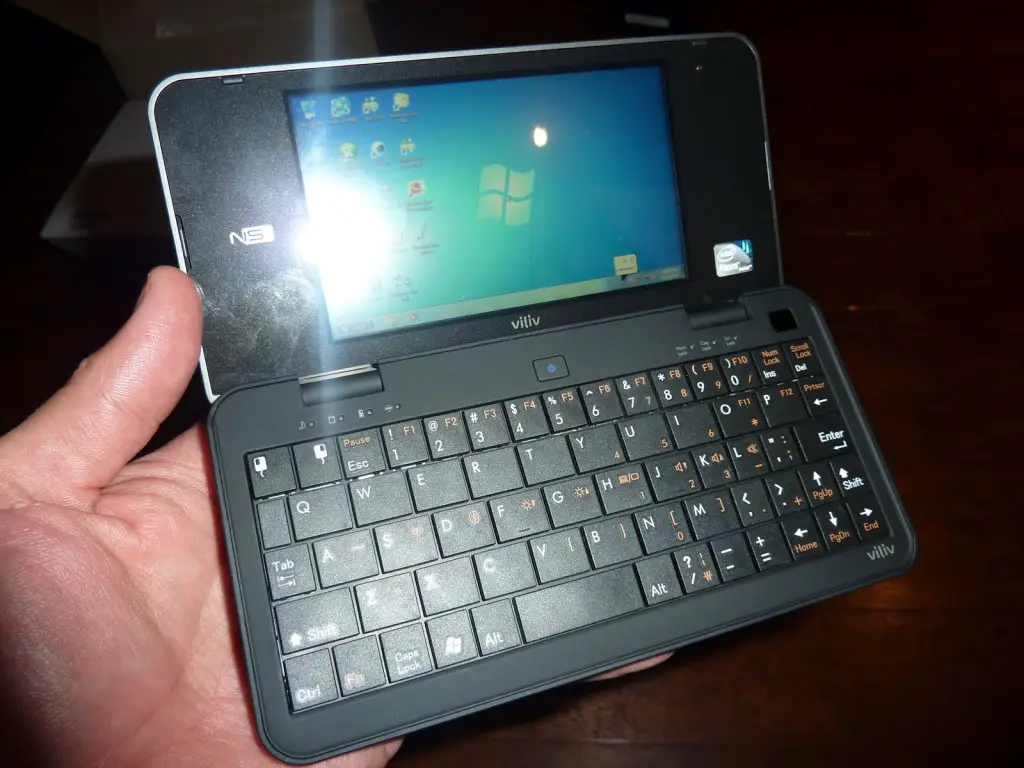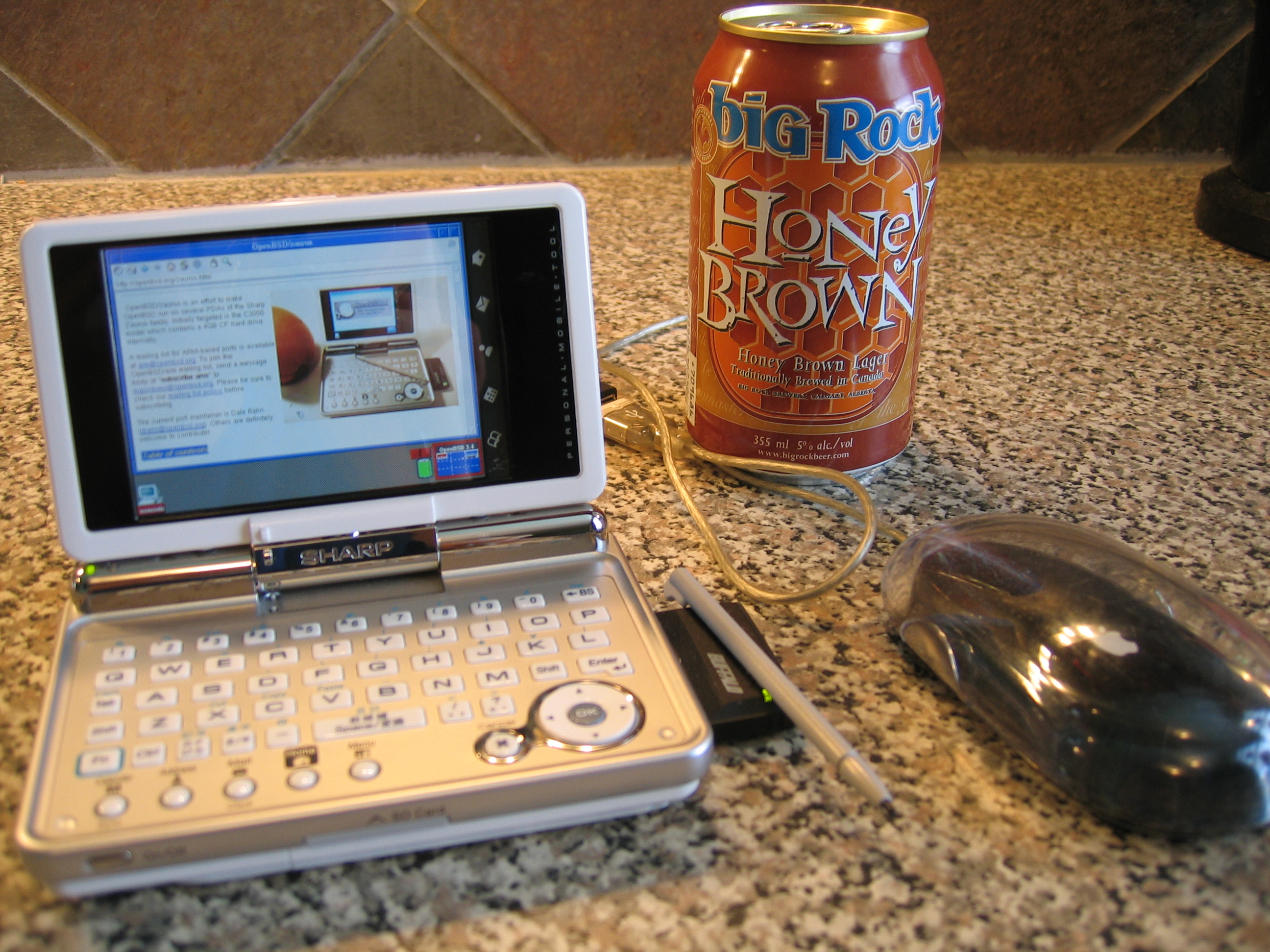hmc
Active Member
Hi guys,
today I got an idea, and I made experiments, and they seem to lead to somewhere
I try to improve the keyboard quality of the Pandora, using parts from a HP 200LX Palmtop's keyboard.
Issue:
The keyboard of the Pandora is much less suitable for quick writing with more than one finger. It's perfect for thumb-typing, when holding the Pandora in two hands, but if the Pandora sits on a table, and I want to type on it like on a laptop, I have a hard time.
On the HP Palmtop 200LX, though, I could write even much faster than on a standard PC keyboard. That keyboard was excellent.
What's the difference between the two keyboards?
It's hard to describe. This is my attempt:
- The Pandora's keys need to be depressed much more (way in vertical direction is larger)
- The Pandora's keys need to be pressed harder all the way down
- The Pandora's keys have a more squashy tactile feedback
This is the HP 200LX:
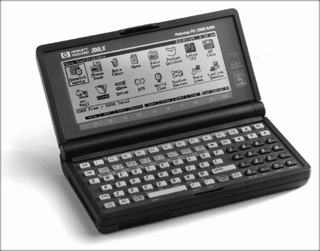
Experiment:
Since I service the 200LX for about 15 years now, I know exactly, how it is built.
Today I had the idea to merge the keyboard "mechanics" of the 200LX with the Panodra's keyboard, in order
- to reduce the vertical way the keys of the Pandora need to travel, until the keypress is recognized,
- to lower the force needed to depress the keys
- to give each key a more defined tactile feedback
The method needs to be refined, and I hope that you can provide some more ideas and knowledge to that, but once I have a well working solution, we may try to bring some of the results also to mass production. At least for Pandora 2, but maybe even earlier.
The 200LX's keyboard is built this way (bottom to top):
It has the key contacts at the bottom, similar to the Pandora.
Then there is a plastic foil with holes in it for each key. It's a spacer for:
The next foil. This one has "bubbles" in it, one for each key. Each bubble has some graphite inside for the key contact.
Then there are the keys, mounted in a grid. Each key has a thin plastic pin, that is placed directly over a bubble.
See this picture (right to left is bottom to top):

More detail:
"Bubble foil" bottom:
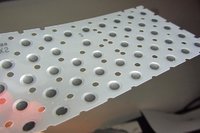
"Bubble foil" top:
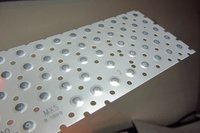
Key grid bottom:
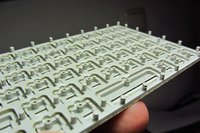
Key grid with fitted bubble foil:
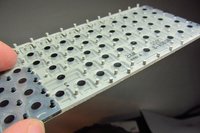
Keyboard top view:
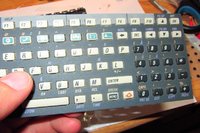
What I did:
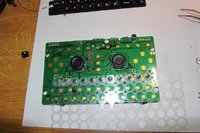
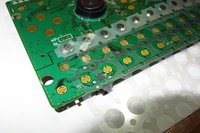
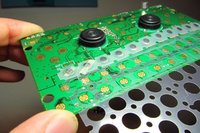
- I cut a row of the bubble foil and fitted it - with the spacer foil in between - onto the key contacts of the Pandora, so that the keys "Q" and "W" were modified.
- Then I fitted the Pandora key mat onto that and tried to press the two mofidied keys.
Result: The keys now have two pressure points, the first one when the Pandora key rubber releases its resistance, and the second when the bubble releases its resistance. Not so good.
- Then I applied small pieces of double-sided adhesive tape onto the bubbles, that I used to attach very small pieces of plastic on top of each bubble, bridging the gap between the bubble top and the Pandora key bottom, in the hope that the Pandora key would directly apply its force onto the bubble and that the result would feel similarly to the 200LX keys.
Result: After adjusting the thickness of the attached plastic parts to about 0.5mm (0.3mm was too thin, 0.8mm was too thick), the key press was now indeed directly applied to the bubble. However, now the mechanical resistance of both the bubble and the Pandora key mat's rubber "mechanics" summed up, making the key even harder to press. The tactile feedback was also not optimal yet.
- Then I cut out one key out of the key mat of the Pandora, placing it directly onto the bubble. I hoped that this would avoid the summed up mechanical resistance and make it easier to press the key. It did. However, the tactile feedback was still not good.
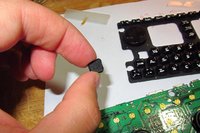
- Analyzing the key I just cut out, squeezing it between my fingers, pressing onto that little thing on the bottom, that originally establishes the key contact when the key is pressed, I found that the entire key, even the inside, is made from elastic rubber, and that makes for a very weak pressure point in combination with that bubble.
Bottom line:
In order to improve the Pandora's keyboard in a way that it feels more similar to a HP 200LX keyboard, we'd need the following:
- A bubble foil that fits the key layout of the Pandora. Does anyone know a source for something like that? Costs? Pandora 1.
- A modified key mat for the Pandora (costs?), with the following differences to the current one:
Maybe, if there are enough people interested in such modifications (I have a lot of former 200LX users in mind, that are hesitant about the Pandora mainly because of the keyboard), these modifications could be financed even for Pandora 1 already, using crowd funding.
Thoughts?
Opinions?
Questions?
Thank you!
Daniel
today I got an idea, and I made experiments, and they seem to lead to somewhere
I try to improve the keyboard quality of the Pandora, using parts from a HP 200LX Palmtop's keyboard.
Issue:
The keyboard of the Pandora is much less suitable for quick writing with more than one finger. It's perfect for thumb-typing, when holding the Pandora in two hands, but if the Pandora sits on a table, and I want to type on it like on a laptop, I have a hard time.
On the HP Palmtop 200LX, though, I could write even much faster than on a standard PC keyboard. That keyboard was excellent.
What's the difference between the two keyboards?
It's hard to describe. This is my attempt:
- The Pandora's keys need to be depressed much more (way in vertical direction is larger)
- The Pandora's keys need to be pressed harder all the way down
- The Pandora's keys have a more squashy tactile feedback
This is the HP 200LX:

Experiment:
Since I service the 200LX for about 15 years now, I know exactly, how it is built.
Today I had the idea to merge the keyboard "mechanics" of the 200LX with the Panodra's keyboard, in order
- to reduce the vertical way the keys of the Pandora need to travel, until the keypress is recognized,
- to lower the force needed to depress the keys
- to give each key a more defined tactile feedback
The method needs to be refined, and I hope that you can provide some more ideas and knowledge to that, but once I have a well working solution, we may try to bring some of the results also to mass production. At least for Pandora 2, but maybe even earlier.
The 200LX's keyboard is built this way (bottom to top):
It has the key contacts at the bottom, similar to the Pandora.
Then there is a plastic foil with holes in it for each key. It's a spacer for:
The next foil. This one has "bubbles" in it, one for each key. Each bubble has some graphite inside for the key contact.
Then there are the keys, mounted in a grid. Each key has a thin plastic pin, that is placed directly over a bubble.
See this picture (right to left is bottom to top):

More detail:
"Bubble foil" bottom:

"Bubble foil" top:

Key grid bottom:

Key grid with fitted bubble foil:

Keyboard top view:

What I did:



- I cut a row of the bubble foil and fitted it - with the spacer foil in between - onto the key contacts of the Pandora, so that the keys "Q" and "W" were modified.
- Then I fitted the Pandora key mat onto that and tried to press the two mofidied keys.
Result: The keys now have two pressure points, the first one when the Pandora key rubber releases its resistance, and the second when the bubble releases its resistance. Not so good.
- Then I applied small pieces of double-sided adhesive tape onto the bubbles, that I used to attach very small pieces of plastic on top of each bubble, bridging the gap between the bubble top and the Pandora key bottom, in the hope that the Pandora key would directly apply its force onto the bubble and that the result would feel similarly to the 200LX keys.
Result: After adjusting the thickness of the attached plastic parts to about 0.5mm (0.3mm was too thin, 0.8mm was too thick), the key press was now indeed directly applied to the bubble. However, now the mechanical resistance of both the bubble and the Pandora key mat's rubber "mechanics" summed up, making the key even harder to press. The tactile feedback was also not optimal yet.
- Then I cut out one key out of the key mat of the Pandora, placing it directly onto the bubble. I hoped that this would avoid the summed up mechanical resistance and make it easier to press the key. It did. However, the tactile feedback was still not good.

- Analyzing the key I just cut out, squeezing it between my fingers, pressing onto that little thing on the bottom, that originally establishes the key contact when the key is pressed, I found that the entire key, even the inside, is made from elastic rubber, and that makes for a very weak pressure point in combination with that bubble.
Bottom line:
In order to improve the Pandora's keyboard in a way that it feels more similar to a HP 200LX keyboard, we'd need the following:
- A bubble foil that fits the key layout of the Pandora. Does anyone know a source for something like that? Costs? Pandora 1.
- A modified key mat for the Pandora (costs?), with the following differences to the current one:
- A harder key, not made from soft rubber, but rather stiff plastic
- A well fitted bottom thing for each key (I don't know how to call it, you know, that knob on the bottom, that establishes the contact normally), which should have a smaller diameter than the current one (otherwise the bubble does not provide that snappy tactile feedback) and which needs to be placed directly above the bubble, with almost no gap in between.
Maybe, if there are enough people interested in such modifications (I have a lot of former 200LX users in mind, that are hesitant about the Pandora mainly because of the keyboard), these modifications could be financed even for Pandora 1 already, using crowd funding.
Thoughts?
Opinions?
Questions?
Thank you!
Daniel




